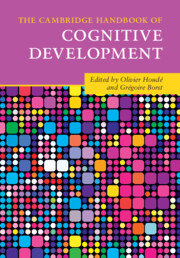Book contents
- The Cambridge Handbook of Cognitive Development
- The Cambridge Handbook of Cognitive Development
- Copyright page
- Contents
- Figures
- Tables
- Contributors
- Introduction
- Part I Neurobiological Constraints and Laws of Cognitive Development
- Part II Fundamentals of Cognitive Development from Infancy to Adolescence and Young Adulthood
- Part III Education and School-Learning Domains
- 25 Linking Cognitive Neuroscientific Research to Educational Practice in the Classroom
- 26 Literacy
- 27 Reasoning in Mathematical Development
- 28 Children’s Scientific Reasoning Skills in Light of General Cognitive Development
- 29 Working Memory Training
- 30 Interventions for Improving Executive Functions during Development
- 31 Curiosity-Driven Learning in Development
- 32 Neurocomputational Methods
- Index
- Plate Section (PDF Only)
- References
32 - Neurocomputational Methods
From Models of Brain and Cognition to Artificial Intelligence in Education
from Part III - Education and School-Learning Domains
Published online by Cambridge University Press: 24 February 2022
- The Cambridge Handbook of Cognitive Development
- The Cambridge Handbook of Cognitive Development
- Copyright page
- Contents
- Figures
- Tables
- Contributors
- Introduction
- Part I Neurobiological Constraints and Laws of Cognitive Development
- Part II Fundamentals of Cognitive Development from Infancy to Adolescence and Young Adulthood
- Part III Education and School-Learning Domains
- 25 Linking Cognitive Neuroscientific Research to Educational Practice in the Classroom
- 26 Literacy
- 27 Reasoning in Mathematical Development
- 28 Children’s Scientific Reasoning Skills in Light of General Cognitive Development
- 29 Working Memory Training
- 30 Interventions for Improving Executive Functions during Development
- 31 Curiosity-Driven Learning in Development
- 32 Neurocomputational Methods
- Index
- Plate Section (PDF Only)
- References
Summary
In this chapter, we consider computational approaches to understanding learning and teaching. We consider the utility of computational methods in two senses, which we address in separate sections. In Section 32.1, we consider the use of computers to build models of cognition, focusing on the one hand on how they allow us to understand the developmental origins of behaviour and the role of experience in shaping behaviour, and on the other hand on how a particular type of model – artificial neural networks – can uncover the way in which the constraints of brain function likely shape the properties of our cognitive systems. In Section 32.2, we consider the use of computers as tools to aid teaching, in particular in the use of artificial intelligence in education.
- Type
- Chapter
- Information
- The Cambridge Handbook of Cognitive Development , pp. 662 - 687Publisher: Cambridge University PressPrint publication year: 2022
References
- 2
- Cited by



